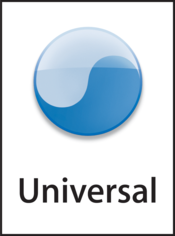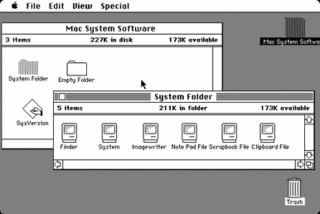In computing, cross-platform software is computer software that is designed to work in several computing platforms. Some cross-platform software requires a separate build for each platform, but some can be directly run on any platform without special preparation, being written in an interpreted language or compiled to portable bytecode for which the interpreters or run-time packages are common or standard components of all supported platforms.
A computing platform or digital platform is an environment in which a piece of software is executed. It may be the hardware or the operating system (OS), even a web browser and associated application programming interfaces, or other underlying software, as long as the program code is executed with it. Computing platforms have different abstraction levels, including a computer architecture, an OS, or runtime libraries. A computing platform is the stage on which computer programs can run.
In computer science, dynamic recompilation is a feature of some emulators and virtual machines, where the system may recompile some part of a program during execution. By compiling during execution, the system can tailor the generated code to reflect the program's run-time environment, and potentially produce more efficient code by exploiting information that is not available to a traditional static compiler.

Mac OS 9 is the ninth major release of Apple's classic Mac OS operating system which was succeeded by OS X. Introduced on October 23, 1999, it was promoted by Apple as "The Best Internet Operating System Ever", highlighting Sherlock 2's Internet search capabilities, integration with Apple's free online services known as iTools and improved Open Transport networking. While Mac OS 9 lacks protected memory and full pre-emptive multitasking, lasting improvements include the introduction of an automated Software Update engine and support for multiple users.
In computing, binary translation is a form of binary recompilation where sequences of instructions are translated from a source instruction set to the target instruction set. In some cases such as instruction set simulation, the target instruction set may be the same as the source instruction set, providing testing and debugging features such as instruction trace, conditional breakpoints and hot spot detection.
The Mac 68k emulator is a software emulator built into all versions of the classic Mac OS for PowerPC. This emulator enabled running applications and system code that were originally written for the 680x0-based Macintosh models. With a few exceptions, notably Connectix's RAM Doubler, the emulator ran all software with no noticeable impact other than lower performance relative to the same program when compiled for PowerPC.
Star Trek is the code name that was given to a secret prototype project, running a port of Macintosh System 7 and its applications on Intel-compatible x86 personal computers. The project, starting in February 1992, was conceived in collaboration between Apple Computer, who provided the majority of engineers, and Novell, who at the time was one of the leaders of cross-platform file-servers. The plan was that Novell would market the resulting OS as a challenge to Microsoft Windows, but the project was discontinued in 1993 and never released, although components were reused in other projects. The project was named after the Star Trek science fiction franchise with the slogan "To boldly go where no Mac has gone before".
PearPC is an architecture-independent PowerPC platform emulator capable of running many PowerPC operating systems, including pre-Intel versions of Mac OS X, Darwin and Linux. It is released under the terms of the GNU General Public License (GPL). It can be executed on Microsoft Windows, Linux, FreeBSD and other systems based on POSIX-X11. The first official release was made on May 10, 2004.
Darwine was a port of the Wine libraries to Darwin and Mac OS X. The Darwine project intended to port and develop Wine as well as other supporting tools that would allow Darwin and Mac OS X users to run Windows applications and to provide a Win32 API compatibility at application source code level.

QEMU is a free and open-source emulator. It emulates the machine's processor through dynamic binary translation and provides a set of different hardware and device models for the machine, enabling it to run a variety of guest operating systems. It can interoperate with Kernel-based Virtual Machine (KVM) to run virtual machines at near-native speed. QEMU can also do emulation for user-level processes, allowing applications compiled for one architecture to run on another.

Rosetta is a dynamic binary translator developed by Apple Inc. for macOS, an application compatibility layer between different instruction set architectures. It gives developers and consumers a transition period in which to update their application software to run on newer hardware, by "translating" it to run on the different architecture. The name "Rosetta" is a reference to the Rosetta Stone, the artifact which enabled translation of Egyptian hieroglyphs.

The universal binary format is, in Apple parlance, a format for executable files that run natively on either PowerPC or Intel-manufactured IA-32 or Intel 64 or ARM64-based Macintosh computers. The format originated on NeXTStep as "Multi-Architecture Binaries", and the concept is more generally known as a fat binary, as seen on Power Macintosh.

The Mac transition to Intel processors was the process of changing the central processing unit (CPU) of Apple Inc.'s line of Mac computers, as well as its server offerings at the time, from PowerPC to Intel x86 processors.

A Hackintosh is a computer that runs Apple's Macintosh operating system macOS on computer hardware not authorized for the purpose by Apple. "Hackintoshing" began as a result of Apple's 2005 transition to Intel processors, away from PowerPC. Since 2005, Mac computers use the same x86-64 computer architecture as many other desktop PCs, laptops, and servers, meaning that in principle, the code making up macOS systems and software can be run on alternative platforms with minimal compatibility issues. Benefits cited for "Hackintoshing" can include cost, ease of repair and piecemeal upgrade, and freedom to use customized choices of components that are not available in the branded Apple products. macOS can also be run on several non-Apple virtualization platforms, although such systems are not usually described as Hackintoshes. Hackintosh laptops are sometimes referred to as "Hackbooks".
SoftPC is a software emulator of x86 hardware. It was developed by Rod MacGregor, who founded Insignia Solutions in 1986 with "about a dozen people who had left the CAD/CAM workstation specialist Computervision", believing in a market opportunity for running PC software on workstations. Originally developed on SPARCstations, the first customer to license the software was Intergraph whose workstation had a proprietary processor architecture. Available originally on UNIX workstations to run MS-DOS, the software was ported to the Macintosh in 1987, and later gained the ability to run Microsoft Windows software. Besides Mac OS, supported platforms included SGI IRIX, Sun Solaris, HP-UX, IBM AIX, NeXTSTEP, Motorola 88000, OpenVMS on VAX and DEC Alpha systems, DEC ULTRIX, and others.

The Apple–Intel architecture, or Mactel, is an unofficial name used for Macintosh personal computers developed and manufactured by Apple Inc. that use Intel x86 processors, rather than the PowerPC and Motorola 68000 ("68k") series processors used in their predecessors or the ARM-based Apple silicon SoCs used in their successors. With the change in architecture, a change in firmware became necessary; Apple selected the Intel-designed Extensible Firmware Interface (EFI) as its comparable component to the Open Firmware used on its PowerPC architectures, and as the firmware-based replacement for the PC BIOS from Intel. With the change in processor architecture to x86, Macs gained the ability to boot into x86-native operating systems, while Intel VT-x brought near-native virtualization with macOS as the host OS.

The family of Macintosh operating systems developed by Apple Inc. includes the graphical user interface-based operating systems it has designed for use with its Macintosh series of personal computers since 1984, as well as the related system software it once created for compatible third-party systems.

The Classic Mac OS is the series of operating systems developed for the Macintosh family of personal computers by Apple Inc. from 1984 to 2001, starting with System 1 and ending with Mac OS 9. The Macintosh operating system is credited with having popularized the graphical user interface concept. It was included with every Macintosh that was sold during the era in which it was developed, and many updates to the system software were done in conjunction with the introduction of new Macintosh systems.

The Mac transition to Apple silicon is the process of changing the central processing units (CPUs) of Apple Inc.'s line of Mac computers from Intel's x86-64 processors to Apple-designed systems on a chip that use the ARM64 architecture. CEO Tim Cook announced a "two-year transition plan" in his WWDC keynote address on June 22, 2020, and the first Macs with Apple-designed systems on a chip were released that November.








